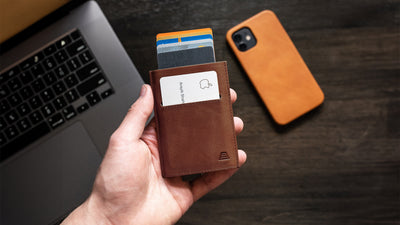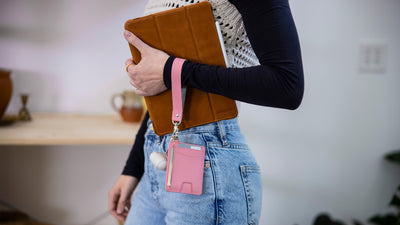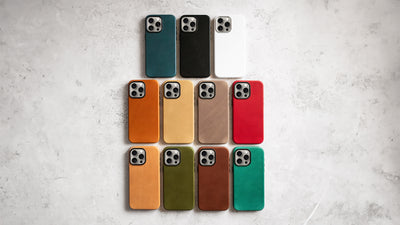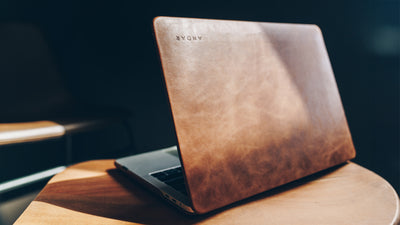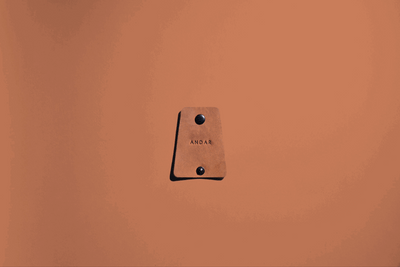The Blog
What Causes Mold on Leather?

Wondering ‘What causes mold on leather'? Mold on leather items or furniture is commonly caused by moisture, humidity, poor ventilation, and improper storage conditions.
Mold can wreak havoc on our cherished leather goods, leading to unsightly stains and damaging the material's integrity.
At Andar, we specialize in handcrafted full-grain products and are here to help you understand and pre-empt this issue.
In this article, we'll explore the causes of mold on leather and offer tips on removal and prevention to keep your leather looking pristine for years to come.
Let's dive in!
What this article covers:- Why Does Leather Grow Mold?
- How to Remove Mold And Mildew From Leather
- How to Prevent Mold on Leather Goods
Why Does Leather Grow Mold?
If you're wondering, ‘Why is my leather turning white?', it could be because of mold growth. Mold on leather also arises from a number of other issues, such as exposure to excessive heat or moldy water, or just not using your leather items regularly.
1. Mold Grows On Leather Due To Its Porosity
Based on our first-hand experience, we've seen that when leather items are stored in humid conditions or come into contact with water, they retain moisture within their naturally porous fibers. This can create an ideal breeding ground for mold spores.
2. Mold Grows On Leather If There Is Heat
Our investigation demonstrated that leather exposed to high temperatures in combination with moisture accelerates mold development.
3. Mold Grows On Leather If Left For A Long Time Without Use
Leather items that aren't used frequently and are stored away for long periods are more prone to mold. A lack of air circulation and light in storage areas leads to stagnant conditions, which mold thrives in.
4. Mold Grows On Leather If It's Left Untreated For Long
Untreated or poorly maintained leather lacks the protective barrier that helps resist mold. It's vital to keep up with regular maintenance to ensure your leather stays mold-free.
5. Mold Grows On Leather When It's Exposed To Moldy Water
Our research at Andar indicates that when leather is exposed to contaminated water, such as flood water or water from a moldy environment, the mold spores can transfer to the leather and begin to grow.
6. Mold Grows On Leather If It's Stored With Other Molded Items
Storing leather items with other mold-infested objects can lead to cross-contamination. Mold spores can easily transfer from one item to another, especially in confined storage spaces.
7. Mold Grows On Leather When It's Exposed To Airborne Mold
When leather is exposed to areas with high concentrations of airborne mold spores, especially in damp environments, it's more likely to develop mold.
By understanding these factors and taking preventive measures, you can keep your leather goods looking their best and remain mold-free.

How to Remove Mold and Mildew From Leather
At Andar, we've developed a straightforward process to help you remove mold and mildew to restore your beloved leather items.
1. Take Safety Precautions
Drawing from our experience, mold spores can be harmful if inhaled or if they come into contact with your skin.
Prolonged exposure to mold spores can lead to health issues such as:
- coughing
- sneezing
- asthma attacks
Always wear gloves, a mask, and work in a well-ventilated area to protect yourself. These precautions will minimize exposure to mold spores and ensure a safer cleaning process.
2. Remove Loose Mold From The Leather Item
Before doing any cleaning, you need to remove loose mold from the leather surface first.
Use a soft brush or a dry, microfiber cloth to gently wipe away the surface mold. This step stops the mold from spreading further and makes the subsequent cleaning process more efficient.
3. Test The Cleaning Solution On A Small, Inconspicuous Area
Before applying any cleaning solution to the entire leather item, first test it on a small, hidden area, such as a corner or an inside flap of the leather item.
As indicated by our tests, this ensures that the cleaning agent doesn't damage the leather or cause discoloration.
4. Apply A Cleaning Solution To The Affected Area
Once you've tested the cleaning agent, apply it to the mold-affected area.
After trying out this product, we recommend using our Andar leather cleaner from The Leather Care Kit. Spray it lightly onto the leather surface, then use a soft, microfiber cloth, working gently in small circular motions to lift the mold from the leather surface.

5. Rinse The Area With A Damp Cloth
After removing the mold with our leather cleaner, rinse the area with a damp cloth made of microfibers to remove any residue.
We determined through our tests that using clean, lukewarm water for rinsing is best, as it helps to ensure that all cleaning agents and residue are completely removed from the leather surface.
6. Dry The Leather Item Completely
Drying the leather item thoroughly is crucial to pre-empt mold from returning. As per our expertise at Andar, air drying is the most effective method.
Once it's dry, place the leather item in a well-ventilated area away from direct sunlight or heat sources, as these can cause the leather to crack or fade.
7. Condition The Leather
Conditioning and treating leather with appropriate products like our specialized leather conditioner from The Leather Care Kit and The Leather Cream nourishes the leather and creates a protective barrier against moisture. These are also excellent solutions for showing you how to fix leather creases, as well.
Be sure to use a clean cloth made of microfibers to apply the conditioner or cream evenly across the surface.
Moreover, The Product Care range from us at Andar can enhance the appearance of our mens slim wallets, encouraging them to develop a rich patina over time with every use.
8. Repeat The Process
In some cases, mold may be stubborn and require multiple cleaning sessions.
That's why repeating the cleaning and conditioning process in steps 1-7 above may be necessary for heavily mold-infested leather items. Be patient and persistent, ensuring that each step is followed thoroughly until the mold is entirely removed.
By following these detailed steps, you can effectively remove mold and mildew from your leather items and ensure they remain in excellent condition.
We're committed to helping you care for your modern leather goods so you can continue to carry what matters.
How to Prevent Mold on Leather Goods
Here are some effective strategies to prevent mold growth on your leather goods.

Keep Leather Dry
Based on our observations, mold thrives in moist environments, so keeping your leather dry is crucial. After using your leather items, ensure they're thoroughly dried before storing them.
Avoid Contact With Water
Water can damage leather and create a breeding ground for mold. That's why you should use water-resistant products to protect your leather from accidental spills and rain exposure.
Regularly applying The Leather Cream from us at Andar can provide an additional barrier against moisture.
Use A Moisture-Absorbent Cloth
When drying your leather items, use a moisture-absorbent cloth. Through our trial and error, we discovered that microfiber cloths are particularly effective at absorbing moisture without damaging the leather.
Gently pat the leather with this type of cloth, which you can find in The Leather Care Kit, to remove any excess moisture and pre-empt mold growth.
Store Leather In A Cool, Dry Place
After conducting experiments with it, we found that storing leather items in a cool, dry place with good air circulation significantly reduces the risk of mold.
It's essential to store leather products like our Andar full grain leather bags or bands for Apple watch in cool, dry places, avoiding areas with significant temperature fluctuations.
Moreover, using breathable dust bags or containers can help maintain optimal conditions for your leather goods.
Clean Mold Off The Leather Immediately
If you notice any mold on your leather items, clean it off immediately to stop further growth. We recommend using our specialized leather cleaner or a gentle solution of water and white vinegar to effectively remove mold.
Apply either with a soft cloth and wipe the leather surface carefully. Then follow up with our Andar leather cream and conditioner to properly moisturize and protect the leather afterwards.
Conclusion
In this blog post, we answered the question ‘What causes mold on leather?', highlighting how moisture, heat, and lack of use contribute to mold growth. With our expert tips on removing and preventing mold, you can keep your leather in top shape.
Ready to experience the luxury of mold-free leather? Explore Andar's handcrafted full-grain leather products today.
Carry what matters, with style and quality you can trust!
If you want to learn more, why not check out these articles below:
- Why Does Leather Peel
- Why Does Leather Crack
- What Does Heat Do to Leather
- How Durable Is Leather
- Why Does Leather Last So Long
- How Durable Is Vegan Leather
- Best Leather Shoulder Bags
- Best Black Leather Bags
- Which Leather Is Best for Bags?
- Best Leather Backpack
- Best Leather Backpacks for Women
- Best Mens Leather Backpacks
- Best Leather Backpack for Travel
- Best Leather iPad Case
- Best Leather Case for iPhone 14 Pro Max
